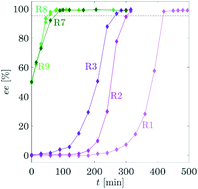Solid state deracemisation of two imine-derivatives of phenylglycine derivatives via high-pressure homogenisation and temperature cycles
Abstract
In the last two decades, the possibility of breaking the symmetry of an initially racemic mixture of two enantiomeric, conglomerate crystals (solid state deracemisation) has been discovered and keenly studied. In this work, we first briefly review the most important deracemisation techniques developed and applied to induce solid state deracemisation in industrial processes, discussing the physical mechanisms, on which such techniques are based. Then, we present deracemisation experiments of two precursors of the drugs clopidogrel and prasugrel, which are of interest for pharmaceutical applications. These experiments aim at showing the efficacy of high-pressure homogenisation and temperature cycles. These are two rather promising techniques, because they can be potentially used in industrial processes, since they allow the achievement of complete deracemisation. However, each of them suffers from a few limitations, such as clogging of the high-pressure homogenisation unit or the longer duration of the process with temperature cycles compared to high-pressure homogenisation. We focus on studying the reproducibility and the duration of the deracemisation process, particularly as a function of the initial enantiomeric excess, so far investigated mainly theoretically, comparing the results obtained with the two different techniques, which we have used.



 Please wait while we load your content...
Please wait while we load your content...